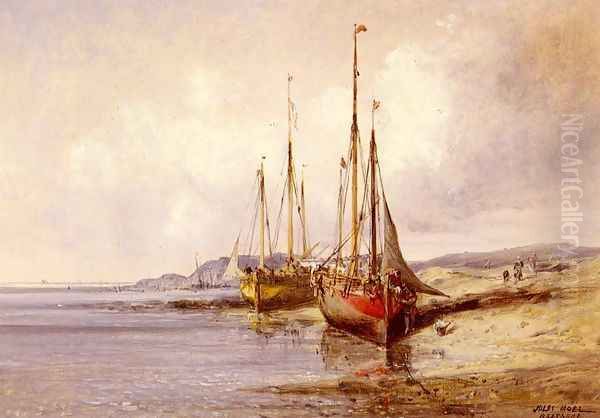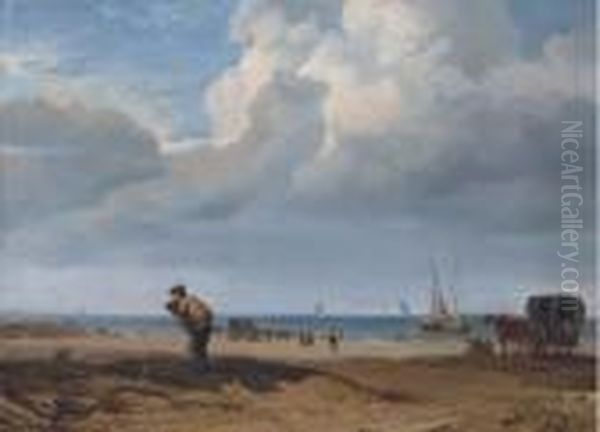
Jules Achille Noël stands as a significant figure in 19th-century French landscape painting. Active during a period of rich artistic transformation, Noël dedicated much of his career to capturing the distinctive light, atmosphere, and daily life of the coastal regions of Brittany and Normandy. His work, appreciated by critics like Baudelaire and sought after by collectors, offers a valuable window into the maritime world of France before the full bloom of Impressionism, blending meticulous observation with a palpable sense of place.
Early Life and Artistic Awakening
Jules Achille Noël was born in Nantes on January 4, 1815, although some sources suggest a possible earlier birth year of 1810 and origins in the Lorraine region. His father, an engineer involved with the Brest-Nantes canal project, provided young Jules with his initial instruction in drawing, nurturing an early inclination towards the visual arts. This foundational training set the stage for his future pursuits.
Seeking more formal education, Noël later studied at the Académie de Peinture et de Dessin in Brest, a key port city in Brittany. This proximity to the sea undoubtedly shaped his artistic sensibilities from an early stage. The rugged coastline, the bustling harbours, and the ever-changing maritime weather would become recurring themes throughout his extensive body of work, demonstrating the lasting impact of these formative years spent near the Atlantic.
The Parisian Experience and Return to Roots
Like many aspiring artists of his generation, Noël eventually made his way to Paris, the undisputed centre of the art world in the 19th century. There, he sought to further his skills and make a name for himself. He encountered the work and possibly the person of Pierre-Julien Gilbert, another painter with Breton connections, whose influence likely encouraged Noël's focus on landscape and marine subjects. Paris offered exposure to a vibrant artistic community and the influential Paris Salon.

However, Noël's initial years in the capital were marked by struggle. Establishing oneself as an artist was a challenging endeavour, often fraught with financial hardship. After a period of perseverance, Noël made the decision to return to Brittany. There, he found a more stable means of support by taking up a position teaching painting, sharing his knowledge while remaining immersed in the landscapes that inspired him most. This return was not an end to his ambitions but a strategic move that allowed him to continue honing his craft.
Building a Reputation: Salons and Commissions
Noël's persistence paid off. He made his official debut at the prestigious Paris Salon in 1840, the primary venue for artists seeking recognition and patronage. Exhibiting at the Salon was crucial for career advancement, and Noël continued to participate over the years, gradually building his reputation among critics, collectors, and fellow artists.
His growing recognition led to significant opportunities. In 1847, he received a grant or commission from the French Ministry of Education. One source indicates this was to create illustrations for Maurice Allem's book, Histoire des Bords de la Mer (History of the Seashores). Another suggests a commission involving illustrations for prison-related publications. These commissions, regardless of their specific nature, demonstrate his established skill and trustworthiness in the eyes of official bodies, further solidifying his professional standing. He also later held a long-term position as a design teacher at the esteemed Lycée Henri-IV in Paris, a role he maintained until his retirement in 1879.
The Essence of Noël's Art: Style and Vision
Jules Noël primarily distinguished himself as a painter of landscapes, marine scenes, and cityscapes, with a particular affinity for the coasts of Brittany and Normandy. His style is characterized by a keen eye for detail, a sensitive rendering of light and atmosphere, and often lively depictions of human activity within the natural setting. He possessed a remarkable ability to capture the specific textures of sand, water, stone, and sail, grounding his scenes in tangible reality.
His work drew comparisons to that of Eugène Isabey, a contemporary renowned for his dramatic marine paintings and historical scenes. Isabey, like Noël, often depicted the Norman coast with energy and atmospheric flair. Both artists navigated the space between Romanticism's dramatic potential and Realism's focus on observable truth. Noël's careful delineation of boats, fishing gear, and coastal architecture aligns him with the Realist impulse, yet his handling of light and weather often evokes a more Romantic sensibility.

The influential poet and art critic Charles Baudelaire noted Noël's talent, praising his work and considering it comparable in quality to established names, which was significant validation. While not strictly a member of the Barbizon School, Noël shared with painters like Jean-Baptiste-Camille Corot an interest in direct observation of nature, though Noël's focus remained more consistently coastal. His attention to transient effects of light and weather also places his work in dialogue with precursors to Impressionism like Eugène Boudin and Johan Barthold Jongkind, who were similarly fascinated by the atmospheric conditions of the Channel coast. He operated within a rich tradition of French marine painting, alongside artists such as Théodore Gudin and Eugène Isabey's father, the marine and historical painter Louis-Gabriel-Eugène Isabey.
Brittany and Normandy Through Noël's Eyes: Key Works
Noël's oeuvre is dominated by scenes drawn from his beloved Brittany and Normandy. He painted bustling harbours filled with fishing boats, tranquil beaches at low tide, dramatic cliffs meeting the sea, and intimate views of coastal towns. Fishermen, sailors, and townspeople often populate his canvases, adding narrative interest and a sense of lived experience to the landscapes. He worked adeptly in both oil and watercolour, and also produced drawings and lithographs.
Several specific works stand out as representative of his talent. The Bretagne, now housed in the National Maritime Museum in Greenwich, London, exemplifies his skill in depicting naval subjects and maritime environments. Historical paintings, though less common, also feature in his work, such as the impressive Napoleon III Receiving Queen Victoria at Cherbourg (1859), capturing a significant diplomatic event with meticulous detail and compositional grandeur.
Other notable works frequently cited include Le Bac (The Ferry, 1857) and Low tide at Tréport (1876), both showcasing his ability to render specific locations and times of day with atmospheric accuracy. A lithograph titled Sunset over Marseille (1872) demonstrates his reach beyond the northern coasts. A painting titled Pasture (1857) indicates his versatility in depicting rural landscapes as well.
A work titled 48 (1854), located in the museum of Vesoul, is described in one source as depicting "rice fields, seaside, fishermen, boats." The mention of rice fields is unusual for Brittany or Normandy and might warrant further investigation or clarification, but it points to the diversity of elements he incorporated into his compositions. Additionally, a known sketchbook containing 43 drawings further attests to his prolific output and his practice of capturing scenes directly from life, featuring landscapes, fishing ports, and ruins.
A Teacher's Influence and Final Years
Beyond his own artistic production, Jules Noël made a contribution through teaching. His long tenure as a design instructor at the Lycée Henri-IV in Paris, from the mid-1850s until 1879, indicates a commitment to arts education. During this time, he would have influenced numerous students, passing on his skills in observation and rendering.
One known student who benefited from Noël's guidance was Albert Lynch, a Peruvian-born painter who later achieved success in Paris, known for his elegant portraits of women. Lynch studied at the École des Beaux-Arts under prominent academic painters like Henri Lehmann and Gabriel Ferrier, but also cited Noël as one of his teachers, highlighting Noël's role in shaping the next generation of artists outside the main academic ateliers.
After a long and productive career, Noël retired from his teaching post in 1879. Seeking a warmer climate due to failing health, he made the decision to leave France. He moved to Algiers, the capital of French Algeria, to live with his daughter and son-in-law. This move marked the final chapter of his life.
Legacy and Remembrance
Jules Achille Noël passed away in Algiers in 1881. Though he died away from the coasts that had so profoundly inspired him, his artistic legacy endured. His work continued to be appreciated and exhibited, notably in a retrospective exhibition held at the Musée des Beaux-Arts in Quimper, Brittany, in the 1950s, bringing renewed attention to his contribution to Breton art.
Today, Noël's paintings and drawings are held in numerous public collections in France, including the Louvre, the Musée d'Orsay (though perhaps indirectly through national collections), regional museums in Brittany and Normandy (like Quimper and Vesoul), and internationally, as seen with the National Maritime Museum in Greenwich. His works also continue to appear regularly at auctions, attesting to a sustained interest among collectors of 19th-century French art.
He remains recognized as a skilled and sensitive interpreter of the French coastline, particularly Brittany and Normandy. His paintings offer detailed and atmospheric records of maritime life and landscape during a period of significant social and artistic change. He successfully bridged the gap between the detailed rendering favoured earlier in the century and the growing interest in light and atmosphere that would characterize Impressionism, carving out a distinct and respected place for himself in the history of French art.
Conclusion
Jules Achille Noël's life and work provide a fascinating glimpse into the world of a dedicated 19th-century French landscape artist. From his early training under his father to his studies in Brest and Paris, his career was shaped by both formal education and direct engagement with the natural world. His struggles and successes, his Salon participation, commissions, and long teaching career paint a picture of a resilient and respected professional. Most importantly, his artistic output – the numerous paintings, watercolours, and drawings of the Breton and Norman coasts – stands as his enduring legacy. With a style marked by careful observation, atmospheric sensitivity, and an affinity for maritime subjects, Noël captured the unique character of these regions, earning the admiration of contemporaries like Baudelaire and securing a lasting place in the annals of French landscape and marine painting.